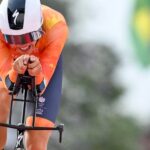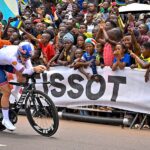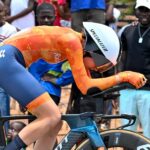
The 2025 Vuelta a España enters its decisive final week with Jonas Vingegaard and João Almeida locked in a razor-thin GC battle, while protests continue to threaten the race’s outcome. Beyond the peloton, major shifts are reshaping the wider world of sports—from Nielsen’s overhaul of TV ratings that could redefine sports economics, to the ongoing fight for equal pay in women’s cycling. Add in Magnus Backstedt’s move to Human Powered Health, U.S. cycling results, and new debates over the future of niche college sports, and it’s clear this week in cycling and beyond is about more than just racing.
# Check out the weekly commentary on pro cycling – and its context within the broader world of sports – with AIRmail … Analysis, Insight and Reflections from The Outer Line. You can subscribe to AIRmail here, and check out The Outer Line’s extensive library of articles on the governance and economics of cycling here. #
Key Takeaways
● Tight Vuelta Enters Final Stages
● Protests Threaten to Disrupt Final Week of the Race
● Nielsen Ratings Changes Will Impact Sports
● Backstedt to Human-Powered Health Team
● Women Cyclists vs. Men: Pay Me Now or Pay Me Later
● Trump Weighs in to Protect Niche College Sports’
The Vuelta enters its decisive third and final week on Tuesday with the GC outcome still hanging in the balance. Jonas Vingegaard and João Almeida remain locked in a duel, separated by just 48 seconds; the notion that Vingegaard could simply walk away with the race in the absence of Tadej Pogačar has long since evaporated. Instead of wide-open fireworks, the GC battle has been marked by cagey, defensive riding. Both Visma-LAB and UAE have generally kept the lid on attacks, disproving the earlier consensus that Pogačar’s absence would open things up and infuse the race with aggressive tactics. While UAE has tightened its race for the GC, it has also hoarded stages, winning seven out of fifteen so far, and continuing to underscore the widening gulf between cycling’s few super-teams and the rest of the pack. The table scraps have been so lean that even the well-funded and ascendant Lidl-Trek squad only scored their first stage win of the race on Sunday, with Mads Pedersen putting on a display of overwhelming strength and speed. Meanwhile, on the opposite end of that spectrum, Movistar, Spain’s lone WorldTour squad, has yet to win a stage, further stretching the drought at their home grand tour starting in 2021. Struggling French squad Cofidis has failed to figure in the race at all and is watching their chances of remaining in the WorldTour vanish, with second-division Uno-X team now leading them by nearly 300 points in the three-year promotion/relegation standings.

Several other events have defined the Vuelta beyond the racing. Repeated disruptions by large-scale pro-Palestinian protests (most notably forcing the neutralization of Stage 11 into Bilbao) triggered crashes when demonstrators breached the high-speed peloton, and threatened a full-scale shutdown of the race. While the presence of the Israel-Premier Tech team has been a flashpoint, the protestors’ indiscriminate tactics have endangered the entire race and raised real doubts about whether the final week, particularly the Madrid finale, can safely go ahead. Frustrations within the peloton have often been directed at IPT riders. Tensions eurpted after a public clash between I-PT director Daryl Impey and Visma’s Matteo Jorgenson over what was said on a private rider’s WhatsApp group; it appeared some riders hope that I-PT will leave the race. It’s not clear at this point, however, that the protests would slow even if I-PT did leave the race. And although the team has stripped “Israel” from its jerseys and insists it holds no official ties to the Israeli government, Prime Minister Benjamin Netanyahu’s recent public backing of the team and its increasingly controversial owner Sylvan Adams has ensured that the conflict and the protests will intensify. It also effectively rules out any possibility of the team’s withdrawal.

The U.S.-based Women’s WorldTour team Human Powered Health has announced the addition of former Paris-Roubaix winner Magnus Backstedt as the team’s sport director. The team’s owner and management firm, Circuit Sport, also confirmed a new three-year commitment from its primary name sponsor – giving the team a comfortable runway to continue expanding into the sport’s top level. (Previously, the team ran both men’s and women’s teams and was known as Rally Cycling, and prior to that as Team Optum, presented by Kelly Benefit Strategies.) Backstedt, who has two daughters currently racing for WWT teams, had an illustrious career with several different WT-level teams, and has since been working as an announcer and with the Cofidis women’s team; he will join HPH in 2026. Although men’s WT teams EF Education First and Lidl-Trek are “American-linked” teams, the HPH women’s team is the only truly American squad in either the men’s or women’s top tier.
Nielsen ratings have been the benchmark for scientific TV broadcast viewership metrics since the 1960s; now the service is receiving its first major facelift in over 50 years – one which could seismically shift sports economics. The evolution of modern content consumption has diluted the data sources that Nielsen can reliably measure as consumers continually shift away from costly cable packages and subscribe to multiple (often more costly) personalized content portfolios from a plethora of platforms such as Amazon, AppleTV, MAX, and others. Nielsen’s new Big Data + Panel seeks to address the gaps in measurements across all of the content modalities to provide a holistic viewership dashboard for free to air, cable, streaming, and multi-modal programming. This new Nielsen methodology may not significantly affect original programming metrics for traditional TV shows and series, but it will drastically shift the sports viewing data as it will now include the number of viewers within a bar or household (so-called “group viewing” events, such as in weekend football parties) and aggregate data from set top boxes and smart TVs from 45 million households and 75 million web-connected devices.
The new Nielsen dashboard will almost certainly bolster the already media dominant position of pro league based sports by potentially many millions more viewers measured per game, including sub-categories such as multi-panel/multi-game viewing common with streaming and enhanced set top services. The new figures will likely drive media license rights to record highs in future broadcast negotiations. Sports content has outpaced original programming by ever larger margins; in 2024, 70% of the most watched programming in the U.S. was NFL games alone. Those licensing increases will almost certainly be passed on to the viewing consumer at some point as waxing and waning in the advertising market fails to keep pace with revenue demands on the broadcast licensees. A criticism of the new Nielsen dashboard is that as a commercial service – not an independent peer reviewed research resource – the data may be accurate but its interpretation can be unreliable. In the past, it has been misused to oversell viewing trends and thus artificially inflate advertising and related investments. But for pro cycling and other niche sports in general, the overloading of league sports metrics could further stress the market and available space in subscription and standalone streaming services, increasing the on-demand per-event viewing costs. Put simply, the general cost to access an entire season of racing content could climb even further. If there was ever a fork in the road for cycling’s stakeholders to re-address the state of the sport’s media rights, this might be it.
 Sandy Dujardin seen at the 2025 Antwerp Post Epic.
Sandy Dujardin seen at the 2025 Antwerp Post Epic.
Sandy Dujardin of Team TotalEnergies took a narrow victory in the third running of the Maryland Cycling Classic. In the revised circuit lap race now held wholly within the city of Baltimore, Dujardin outsprinted breakaway companions Jonas Abrahamsen and Marius Mayrhofer in a rain-soaked battle to take a close win. In the women’s race, held earlier in the day and in calmer weather, the Polish rider Agnieszka Skalniak-Sójka of Canyon SRAM took the sprint victory. One interesting contrast that emerged during the team introductions at this event is the number of the women who race while simultaneously holding professional level jobs in fields such as medicine, law, and software technology; several doctors and lawyers were on the course Saturday. In contrast, many of the men racing have no formal education beyond the high school level. This observation obviously cuts both ways; while men get paid a living wage to race, many women don’t. On the other hand, when women stop racing, most are able to move seamlessly into other careers, whereas many of the men struggle to find any sort of career outside of cycling. Neither situation seems optimal. The Maryland race is now the highest-ranked UCI event held in the U.S.; it will be interesting to see where it goes in the future.
The Women’s WorldTour has gone from strength to strength in the few short years of its current top-tier UCI designation, but has begun to show growing pains at a critical evolutionary juncture. The sport’s top six teams have gradually accumulated the majority of the women’s peloton top riders and locked them into multi–year contracts, leading to exciting racing across the WWT and Pro level calendar. But an undeniable talent development pipeline weakness has exposed cracks in the sustainability model for the sport’s future: there is not enough investment and support to bring up burgeoning elite riders who have the talent to eventually race at the WWT level. Too many teams are instead over-investing and over-committing to veteran pro riders who will age out of the peloton before adequate replacement talent can break in with their first pro contract. This was highlighted recently by the immediate dissolution of the Hess development racing team in Britain, and the shift to general crowdfunding by the similarly-focused U.S. Cynisca team. A near-clean sweep of the Simac Ladies Tour in the Netherlands last week by SDWorx sprinter Lorena Wiebes wasn’t just a demonstration of racing prowess, it was also a symptom of the talent-loading problem. As we noted last week, the recent women’s Tour de l’Avenir provided young riders with a springboard to get noticed by WWT teams, but the talent disparity from the top ten riders to the final twenty finishers was obvious. Critical voices are rising from within the sport’s observers and WWT pioneers to refocus on the fundamentals of talent building before the sport’s commercial ambitions outgrow its athlete resources.
For scholarly commentary on the transformative situation in college sports, we turn once again to The Atlantic, which weighed in recently on the demise of niche college sports – opining that the paying of revenue-generating college athletes is long overdue – even if it “means letting squash and water polo die.” For too long, the system of college athletics has been fundamentally unfair, this writer argues. “The football and basketball players, disproportionately Black and poor, entranced millions of TV viewers and enriched their universities. Rather than compensating them, administrators turned around and spent much of the money subsidizing teams that go largely unwatched.” In this struggle between niche sports, including collegiate cycling, and the larger and more powerful football and basketball programs, President Donald Trump has, interestingly, seemed to side with the former. In an executive order signed last month, Trump declared that “opportunities for scholarships and collegiate athletic competition in women’s and non-revenue sports must be preserved and, where possible, expanded.”
The post Vuelta 2025 Tightens as Nielsen Ratings and Women’s Cycling Spark Debate appeared first on PezCycling News.





